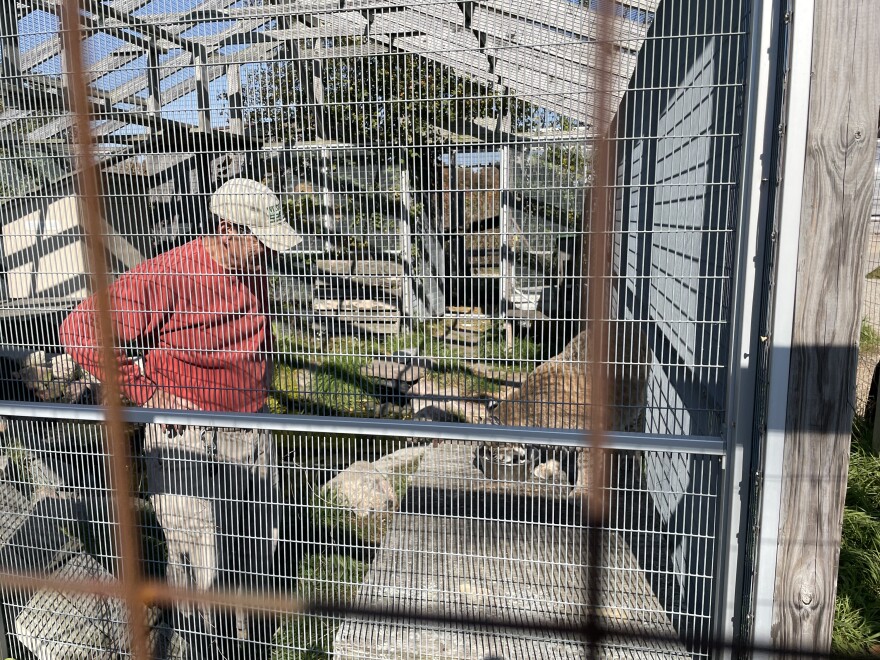For 44 years, Illinois banned bobcat hunting. That changed in 2016, when the state started a lottery for permits to hunt the predators. And every year since Illinois has hosted a bobcat hunting season.
So far, the state has hosted six hunting seasons and hunters have nabbed more than 1,600 bobcats. Stan McTaggart with Illinois Department of Natural Resources says that the lottery for hunting permits limits the numbers that get killed.
“We usually get about 6,000 applications per 1,000 permits,” said McTaggart, “so your chances of success are pretty low. But that kind of spreads out the pressure on bobcats.”
Bobcats were hunted to near extinction in parts of the American Midwest. Throughout the 1960s and 1970s states began putting the lynx on protected species lists in order to prevent population collapse.
The bobcat has made a huge comeback and since the 1990s hunting for the predator has reopened across the country. Yet, even as bobcats thrive some question the necessity of harvesting the cats.

Jennifer Kuroda started a not-for-profit organization called the Illinois Bobcat Foundation after the state opened the season on the bobcat. Since then, she’s been an outspoken critic of the practice. Kuroda says she understands that bobcats are one of the most adaptable mammals on the continent, but that’s besides the point.
“There's definitely not any concern for the status of bobcats in the United States right now,” she said. “But do we need to hunt them?”
For the past seven years Kuroda has lined up for one of the bobcat hunting permits Illinois issues each year — with plans to leave it unused and possibly save at least one of the wildcats.
“I have applied for a permit not to use since the very beginning, and I've never received one,” said Kuroda. “So the odds are unlikely, but I still feel it's a method for me to be involved and have a voice in the conservation of bobcats.”
Wildcat
The bobcat is a medium-sized lynx with a short bobbed tail, hence the name, and dense brown-gray fur along its back, with a whitish underside speckled with black. That makes it prized by hunters and trappers of furbearers. The best pelts can fetch hundreds of dollars, with pelts from the western U.S. typically going for a higher premium than those from the east.
Viorel Popescu is an associate professor in the Department of Biological Sciences at Ohio University in Athens, where he researches quantitative wildlife ecology and lately, bobcat populations. He says that habitat destruction coupled with the fur trade led to a decline in bobcat populations by the 1850s throughout the Midwest.
“They were never in danger of extinction,” said Popescu. “But they had been extirpated from several Midwest states like Ohio, Indiana, Illinois.”
The bobcat is not a federally endangered species. They're one of the most widely distributed, medium-sized mammals in the country, second only to the raccoon. Popescu adds that today the lynx’s range spans nearly the entire United States, and parts of Canada and Mexico.
Still, a handful of states, including Indiana and Ohio, continue to ban bobcat hunting. Indiana, for example, shot down a 2019 proposal to open a season for the lynx. That same year, California officials closed their bobcat season until further notice.
Popescu says that although bobcat populations were able to return to Midwestern states, arriving at any official count or estimate of the total existing population is complicated by the cryptic nature of the species.
“And the estimates of total numbers of bobcats are really unknown,” he said. “What we know for sure are some very localized densities from very focused studies.”
Open season
Currently there is no population estimate of the number of bobcats in Illinois, and the whole northeast quadrant of the state is off limits to bobcat trappers and hunters. Some counties are cut right down the middle, where hunting is allowed on one side but not the other.
Similarly, Oklahoma does not have a solid number to point at when it comes to bobcat populations. Jerrod Davis, a senior biologist with the Oklahoma Department of Wildlife Conservation, says that’s not necessarily a bad thing.
“If you have a very accurate estimate of how many animals you have in a state, you have a problem,” said Davis.
For others, that’s a cause for concern.
Laura Nirenberg founded the Center for Wildlife Ethics in Indiana and has been executive director for three decades. She’d like to to keep bobcat season closed in the state, even though just across the state line in Illinois, it's allowed. She says that the self-reported sightings don’t necessarily translate to verifiable proof.
“I can't tell you how many times people see a stray dog and say that they've got a coyote. My point is they're not trained,” said Nirenberg. “Their intentions might be pure, they might want to help the bobcat and or the department, but that doesn't mean that the information being gathered is valid.”

Oklahoma hunters and trappers also kill thousands of bobcats a year. States like Colorado, Montana, Nebraska, Nevada, Utah, Wyoming similarly average a thousand bobcats per season.
Stan McTaggart says the number in Illinois is just north of 300 bobcats annually. Even after six seasons, McTaggart says that the state is confident that the population of bobcats is increasing.
“Our surveys for bobcats show increasing trends and abundance based on deer hunter surveys and archery deer hunters,” said McTaggart.
This year, though, perhaps it will be one fewer.
In October, for the first time since the season opened in the state back in 2016, Jennifer Kuroda was surprised with a notification that she had received one of the Illinois bobcat permits.
“So yeah, it says lottery winner, like the subject line says 'lottery winner' and then it says, 'Jennifer, congratulations,'” said Kuroda. “'The bobcat hunting drawing 2022 is complete, you are successful in being issued a permit.'”
The way she sees it, by holding onto her permit she increases her odds and everyone else’s of catching a glimpse of the elusive lynx in the wild someday.
This story was produced in partnership with Harvest Public Media, a collaboration of public media newsrooms in the Midwest. It reports on food systems, agriculture and rural issues. Follow Harvest on Twitter: @HarvestPM.


